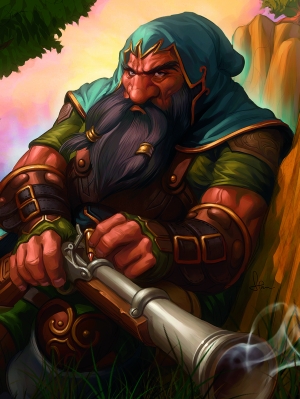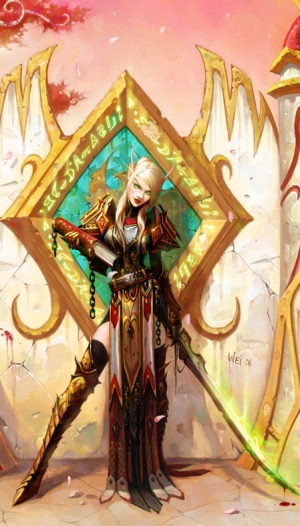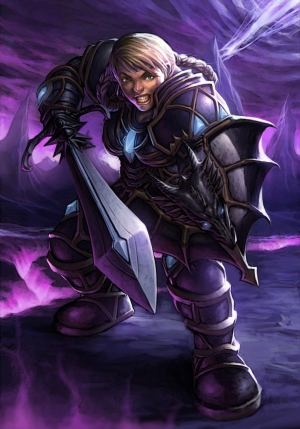
Here’s a fun thought exercise for you all: explain the differences between Fire Mages and Destruction Warlocks in World of Warcraft. But before you do so, let’s make things a little more interesting by saying that you cannot use abilities, rotations, or resources to differentiate between the two of them. In other words, you can’t differentiate them based upon what they do; you can only differentiate them based upon what they are.
In this case, it’s not very difficult. Fire Mages are masters of fire magic through careful study and practice. They’ve mastered the art of flame almost as a thought exercise, specializing in the most destructive form of arcane application but still primarily devoted to learning. Destruction Warlocks, meanwhile, have forged pacts with demons to borrow the intrinsic powers of the nether realms. It’s possible – even probable – that those pacts will eventually have an additional cost, but for the time being the Warlock may use demonic powers for personal gain.
This is the importance of class fantasies and why they’re important to the game moving forward. And it also demonstrates the problem with them, and it hints at why these fantasies have suddenly become more important with Legion.
 At its heart, a class fantasy is simply a declaration of what a class is without regard for what that class can do. The reasoning, of course, is that what a class can do is intensely variable, and you can justify almost anything as an ability set if you want to. You can justify any class/race combination if you want it to happen. I could write up a convincing explanation that Paladins should have full access to Warrior abilities as well as normal Paladin abilities based solely upon the air of the classes in question. Fiction and fantasy by its lonesome can be used to justify almost anything.
At its heart, a class fantasy is simply a declaration of what a class is without regard for what that class can do. The reasoning, of course, is that what a class can do is intensely variable, and you can justify almost anything as an ability set if you want to. You can justify any class/race combination if you want it to happen. I could write up a convincing explanation that Paladins should have full access to Warrior abilities as well as normal Paladin abilities based solely upon the air of the classes in question. Fiction and fantasy by its lonesome can be used to justify almost anything.
Class fantasy isn’t about rotations or abilities; it’s about how the class should look and feel. It’s a guideline. It’s about how you could give Arms Warriors, Retribution Paladins, and two-handed Frost Death Knights the same functional abilities while still making each spec feel different from the others. Sure, all three of them may apply a DoT effect, but one of them has a bleeding wound, one has a supernatural plague, and the third is burning you with the light of holy purity.
In the early days of World of Warcraft, this was not really heavily used. Shamans, Paladins, and Druids all had pretty concrete class fantasies, but that had more to do with their relative rarity than anything. Warrior encompassed a very broad swath of general ability, Hunters blurred the lines between melee and ranged damage, Priests encompassed everything from the Night Elves and their worship of Elune to the fallen Undead practitioners and the hard-lined beatific leaders of the church in Stormwind. There was no clear picture about what these classes were.
In short, they didn’t have clear fantasies. They had a broad spread of different possible fantasies, and due to the way that talents and the like worked, you could try to hammer your personal fantasy into your gameplay style. It didn’t always work, but that seemed to be the overriding idea.
The problem there seems kind of obvious, based on above definitions – this means defining your character by what you can do rather than what you are. Take away, say, a Shadow Priest’s ability to restore mana in early gameplay, and what are Shadow Priests? What sort of fantasy surrounds them? What identity do they possess? What thematic place do they hold in the world of the game? The answer is that they didn’t have much of one; there was the vague sense that Shadow was the realm of the Forsaken, but it wasn’t really defined as such. As spec choice became more and more rigid and lockstep, this became more and more of an issue.
 Iconic NPCs didn’t exactly help matters. Thrall is often used as the game’s iconic Shaman, but his abilities don’t correspond to any given Shaman spec and never really have: He wields a single one-handed weapon, uses extensive elemental damage spell, and also does a lot of melee damage. Heck, at one point I’m pretty sure he was charging his hammer and throwing it around, which is more of a Warrior trick. It all worked mechanically well enough, but it meant that there was no real definition for the specs beyond the mechanical abilities that they had always had.
Iconic NPCs didn’t exactly help matters. Thrall is often used as the game’s iconic Shaman, but his abilities don’t correspond to any given Shaman spec and never really have: He wields a single one-handed weapon, uses extensive elemental damage spell, and also does a lot of melee damage. Heck, at one point I’m pretty sure he was charging his hammer and throwing it around, which is more of a Warrior trick. It all worked mechanically well enough, but it meant that there was no real definition for the specs beyond the mechanical abilities that they had always had.
We’ll soon have a total of three classes we didn’t have when the game started, and for all intents and purposes the game has moved on to having each spec play as its own class. There’s a thematic link between Retribution and Holy Paladins, for example, but in gameplay terms they’re completely separate. And that, ultimately, is what seems to necessitate a refocus upon class fantasy, because it’s no longer enough to say that your character is just “a Priest.” The identification has come unmoored.
In some ways, this is a negative, because we have gotten accustomed to defining our characters by what they do and not what they are. Shadow Priests, for example, have long been in a state of limbo in terms of what they are, which means that you could attach any meaning you wanted within the overarching definition of “Priest.” Fallen preacher? Emissary of the Nether? Psychic vampire? There’s been room to fit all of them in there, and more besides. Making Shadow Priests devoted servants/users of the Old Gods is one valid reading, but there have been several others.
But the flip side is that so long as the class didn’t have any real individual definition, it was defined entirely by what it could do rather than what it was. I remember as a Retribution Paladin that I was upset when more specs started getting Replenishment in Wrath of the Lich King because that was one of the main components of my spec. Not that I was differentiated from the Arms Warrior by theme and design, but that I was different solely based on offering a buff that that class couldn’t.
Defining the class fantasy means losing some abilities that we’re accustomed to having, and it also means anchoring a lot of definitions in a less flexible framework. If you’ve been playing Demonology for a long time, you’ve had plenty of space to anchor your character in the idea that said character is really more demon than human (or more demon than Orc or whatever), so to be told that this is no longer a valid reading of your character is kind of unsettling. Sure, you can ignore it, but you no longer have Metamorphosis to play around with.
 However – and here’s the crucial thing – from a design standpoint, it’s kind of inevitable. At this point, there are 13 different melee damage specs to balance. Differentiating all of them by what they can do would require a pretty narrow ability list for all of them, and it would ultimately feel a lot less satisfying than balancing them around what they are.
However – and here’s the crucial thing – from a design standpoint, it’s kind of inevitable. At this point, there are 13 different melee damage specs to balance. Differentiating all of them by what they can do would require a pretty narrow ability list for all of them, and it would ultimately feel a lot less satisfying than balancing them around what they are.
And it’s working in positive ways. Enhancement’s resource generation feels familiar, sure, and there’s space to critique that, but it has the hard-hitting elemental damage feel to it, along with several abilities that are out of the box when it had to use abilities that Elemental also had. Retribution has an optional teleport ability. Shadow has gone from “The Priest Damage Option” to having a really cool air and fiction to itself. Rogue has three different specs which all feel different, despite the fact that all three are dual-wielding melee damage dealers with similar core rotations.
It means some tumult and some loss in the short term, but carving out more decisive spaces now means that the same spaces will be more useful in the longer term. That’s a good thing, I’d say.
Feedback, as always, is welcome in the comments below or via mail to eliot@massivelyop.com. Next time around, I want to take a look at the rebooted alpha, promises that haven’t been kept, and what I’m excited for with the latest round of test builds.
 War never changes, but World of Warcraft does, with a decade of history and a huge footprint in the MMORPG industry. Join Eliot Lefebvre each week for a new installment of WoW Factor as he examines the enormous MMO, how it interacts with the larger world of online gaming, and what’s new in the worlds of Azeroth and Draenor.
War never changes, but World of Warcraft does, with a decade of history and a huge footprint in the MMORPG industry. Join Eliot Lefebvre each week for a new installment of WoW Factor as he examines the enormous MMO, how it interacts with the larger world of online gaming, and what’s new in the worlds of Azeroth and Draenor.














